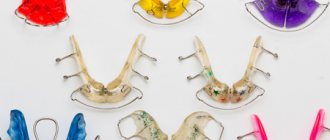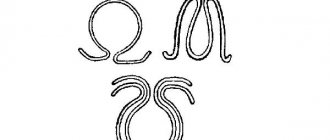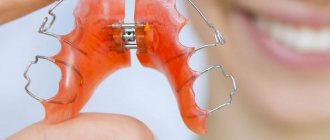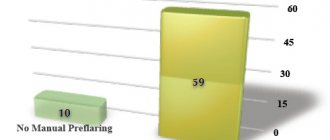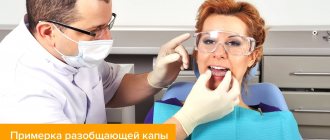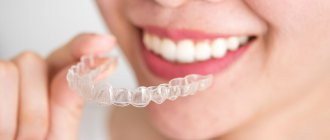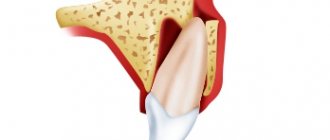Screws are widely used in orthopedic surgery as one of the main components of fixation.
An orthopedic screw can act either as an independent fixation instrument or in more complex designs in combination with intramedullary pins or on- or periosteal plates.
Also, a cortical screw is used as a tensioner - an “anchor” in this type of operation such as tension osteosynthesis . In this case, a tension wire is attached to it.
Indications for the use of microimplants
- Orthodontic treatment. In orthodontics, mini-implants are used as additional support for a brace system. Their installation is required if selective correction of the position of the teeth is required. For example, if one tooth is displaced relative to its axis or has an incorrect position. However, all other teeth do not require correction. Fixing a brace on an adjacent healthy tooth can lead to the risk of it moving. A microimplant allows you to reduce this risk to zero. It is screwed into the gum and serves as a support for the braces system, balancing the pressure. The teeth move along the trajectory planned by the orthodontist. In this case, healthy units are not affected. After treatment is completed, the rod is removed.
- Orthopedic treatment. In orthopedics, microimplants are used as a support for removable dentures. To fix the prosthesis, it is usually necessary to implant 4-6 microimplants, after which the system copes well with the occlusal load. Due to their miniature size, they take root even in the upper jaw with bone atrophy. The microimplant can be loaded immediately after installation, without waiting for complete osseointegration. Compared to classic implantation, this is a less invasive procedure. Therefore, it is suitable as an alternative to conventional dental implantation for certain contraindications. A microimplant can be installed in case of bone atrophy, contraindications to osteoplasty, or complicated clinical picture.
Treatment mechanism
Removable orthodontic appliances are divided into devices:
1 . Mechanical action - influence the teeth and dentition through mechanical elements. These are different types of plate devices.
2. Functional action. - regulate impaired functions that affect the formation of bite, and due to this prevent or eliminate the development of dental anomalies. This group includes trainers, function regulators, and individual functional devices.
3. Combined - combines mechanical and functional properties at the same time.
Removable orthodontic appliances of standardized systems are selected by the doctor according to size, rigidity and other parameters, while individual ones are made from impressions in a dental laboratory. Most often, such structures are used in childhood and adolescence, helping the jaws to form in the desired closure. Thanks to this, permanent teeth are able to grow in the correct, physiological position. In adults, these structures can be used as additional methods in correcting malocclusion.
Removable orthodontic appliances primarily eliminate the causes of malocclusion, allowing the teeth to return to their place on their own. Plates and trainers also solve other problems: they improve the functions of speech, breathing and swallowing, correct the position of the tongue, and reduce the pressure of the jaw muscles on the teeth. Often they are indispensable in order to consolidate the results of treatment with braces.
Timely treatment with removable appliances for correcting occlusion at the stages of temporary and mixed dentition can prevent the development of malocclusions, facilitate and shorten the treatment time for this disease during the period of permanent dentition.
Often, timely treatment during the period of temporary and mixed dentition leads to the formation of a correct permanent dentition.
Contraindications
Microimplants are less traumatic than conventional implants, but their installation has a number of contraindications. Most of them are not absolute. A final decision on the possibility of installing a microimplant will require examination and, possibly, additional treatment. Contraindications include:
- Diabetes mellitus in the stage of decompensation.
- Inflammation in the oral cavity.
- Gum diseases.
- Loose bone tissue.
- Mental illnesses.
- Oncological diseases.
Microimplants should not be placed on patients who smoke. Smoking slows down the healing process, which can cause various complications and reduce the effectiveness of orthodontic treatment. Therefore, patients who are not ready to give up the habit will have to use alternative options.
Installation process
The Bio-Ray mini-implant installation protocol includes the following operations:
- Treating the surgical field with an antiseptic. The facial skin is treated with 70% ethyl alcohol, the oral mucosa is treated with an antiseptic solution;
- Anesthesia of the installation area. Infiltration and application anesthesia can be used.
- Creation of a depression in the mucous membrane and cortical plate with an angled probe.
- Screwing in the Bioray system using a special tool.
During installation and operation, it is recommended to observe the following rules:
- have a distance between the outer surface of the miniscrew and the periosteum of at least 1 mm;
- if possible, you should choose a place for installation in which the mucous membrane is as motionless as possible;
- use allows the application of force up to 500 g;
- proper care consists of the most gentle, careful cleaning of the area around the mini-implant using small brushes, and, if necessary, treating the implant insertion site with a swab soaked in a chlorhexidine solution.
Most often, Bio-Ray miniscrews are used in combination with braces using the straight wire technique. However, their use in treatment with other orthodontic devices cannot be ruled out.
The video shows the process of installing microimplants.
Advantages of microimplants in orthodontic treatment
- Reducing treatment time. During orthodontic treatment, the patient wears a non-removable corrective appliance for a long time. The use of microimplants allows you to reduce the time required for bite correction.
- Lightening the braces system. In traditional treatment, additional elements are used to provide a counterweight, which are attached to the braces. This makes the structure heavier and can cause discomfort for the patient.
- Correction accuracy. The pressure force of the bracket system and the speed of tooth movement are planned at the preparatory stage of orthodontic treatment. Since microimplants, rather than your own teeth, are used as support for braces, a more accurate calculation can be made.
- Good survival rate. Despite the fact that microimplants are a relatively new technology in orthodontic treatment, we can already say that they take root well and do not cause complications. There is no risk of rejection, inflammation, or damage to bone tissue. Therefore, mini implants can be used even in patients with thinning gums.
- Installation in the right place. The microimplant is short in length, so it can be implanted anywhere in the gums. On the upper jaw they can be installed next to the maxillary sinuses. There is no risk of damaging them during implantation.
- Easy to remove. For orthodontic treatment, a titanium screw is installed for a period of about six months. After which it is removed from the gums without damaging the tissue.
"Twin-block" device
The Twin-Block device consists of two plates that correctly position the upper and lower jaws between each other. Used to treat mesial, distal and open bites. More often used in the treatment of the second skeletal class, deep overlap of the upper jaw with the lower jaw, when the lower jaw is located too posterior to the upper jaw, disrupting the bite, muscle function and facial aesthetics.
The design of the device includes the required number of screws and additional elements, based on the individuality of the case and its complexity. For the development of the jaws in their correct position, preventing the development of dysfunction of the temporomandibular joints, already in adolescence. It is used for children under 14 years of age, the device is worn around the clock, the treatment period takes 9-12 months. Food intake is also carried out in the apparatus, to enhance the effect and form correct skeletal growth.
Activation of the device and screws is carried out by the patient himself, and periodic visits to the doctor are necessary to correct the device, polish it, and monitor the patient’s well-being. The device is removable, but for constant wear, it is removed by the patient for the duration of oral hygiene and hygiene of the devices themselves.
Advantages of microimplants in prosthetics
- You can do without bone grafting. For primary stabilization of the implant, a sufficient amount of bone tissue is required. If a tooth has been lost for a long time, the bone will atrophy. A traditional implant can be installed only after osteoplasty. Microimplants require less bone volume, so they can be implanted in patients with bone atrophy.
- Can be used for immediate load protocols. The microimplant is able to withstand occlusal load normally. Therefore, such systems can be used for implantation with immediate loading of a lightweight adaptive prosthesis. Immediately after the operation, the patient can lead a normal life, following the doctor’s recommendations.
Installation of a microimplant is a minimally invasive procedure. The rod is screwed through a puncture in the gum, so there is no need for suturing. The risk of infection, rejection, and peri-implantitis is minimal.
Their main features and advantages:
- Easy to screw in. This is facilitated by the sharp tip of the screw. To implant it into the jaw, you do not need to pre-drill a hole. Manipulation is easily performed using a dental screwdriver.
- Comfort after installation. The head of the Bio-Ray miniscrew has a streamlined shape, so it does not cause discomfort and does not scratch the mucous membrane of the tongue during conversation and eating.
- Small size of the head - the patient practically does not feel the product in the oral cavity.
- Possibility of repeated use in one patient. These screws are easily removed without deformation, so if necessary they can be screwed into a new location.
- Thoughtful carving. Bio-Ray miniscrews presented in our online store are securely held in the jaw bone and do not change their position throughout the entire period of use. They effectively perform their supporting function.
- High strength. This is due to the fact that the screws are made of stainless steel.
- Affordable price. Bio-Ray miniscrews cost from 3,900 to 4,900 rubles (the cost depends on the type of product).
- Possibility of installing two elastic chains or closing springs at once. This was made possible thanks to a specially designed propeller neck design.
After removing the mini-implants, there are no traces, since their diameter is 2 mm, and the depth of screwing into the bone tissue does not exceed 3 mm.
In addition, the desire to buy Bio-Ray miniscrews is explained by the minimal number of contraindications and the possibility of implantation into the jaw of an elderly patient.
Implantation stages
Just like before classical implantation, the installation of microimplants requires a preparatory stage and diagnostics. The implantologist prescribes an instrumental examination: x-ray, panoramic image, computed tomography. The images help to assess the location of teeth and their roots, the volume and density of bone tissue. Using the images, the doctor makes 3D modeling and plans the operation.
Oral preparation will also be required. It is necessary to undergo examination by a dentist. If caries or other oral diseases are detected, they are first treated. If there are contraindications, consultation with a specialized specialist may be required.
If there are no contraindications, the doctor will prescribe the procedure. The implantation of microimplants is a minimally invasive operation that takes about 15 minutes. The installation is done under local anesthesia. In some cases, if there are indications, for example, the patient’s panic, sedation is used.
The surgical stage does not require cutting the gum and its subsequent suturing. The implantologist makes a small puncture into which a screw is screwed. Since mini-implants have good primary stabilization, an orthodontic appliance or an adaptive prosthesis can be installed immediately.
After completion of the procedure, the doctor will give recommendations for oral care. If necessary, he will recommend anti-inflammatory and painkillers. Despite the fact that the implantation of microimplants is a gentle, low-traumatic procedure, in the first days there may be pain, swelling of the gums, and slight bleeding. These are normal phenomena that will go away on their own within 2-3 days.
Types of structures
In most cases, mechanical devices belong to the category of non-removable structures, the wearing of which does not require removal during the treatment period. Depending on the specifics of the diagnosed pathology, as well as the area of its localization, the use of the following types of orthodontic devices is allowed.
Maxillary
The models used to expand the upper arch, as well as correct the position of individual elements, include:
- Coffin spring systems are plates with a single or double spring element that provides sufficient pressure to move the teeth and sectorally expand the arch.
- Screw devices are structures designed to lengthen the frontal segment and expand the row, with a step-by-step change in the structure in the range of 0.75-1 mm per month.
- Plates with a fan-shaped screw - provide symmetrical stretching, as well as the formation of a uniform dental system with a natural anatomical position of the elements.
Mandibular
To lengthen the lower arch, systems are used that differ in their operating principle and configuration:
- Devices with a Koller spring - used for unilateral or symmetrical stretching, providing for the presence of a clasp, or a spring with five semicircular bends;
- Screw models are structures equipped with two guides, located in the alveolar region above the frenulum. If there is a need for extension, they can be combined with two screws.
The choice in favor of one design or another is determined by the clinical picture obtained as a result of diagnosis and a comprehensive examination of the condition of the oral cavity. The duration of wearing depends on the severity of the defect, and varies from a couple of months to one and a half to two years.
How do microimplants differ from traditional implantation systems?
The main design difference is the size of microimplants. They are much smaller than traditional implant systems. They also differ in purpose of use. Their main purpose is orthodontic treatment. This is a temporary structure that will act as additional support for the braces system. After treatment is completed, the screw is removed from the gum. In prosthetics, microimplants are used to fix lightweight removable dentures when it is not possible to do full-fledged dental implantation.
Dental implants are intended for the treatment of edentia, including complete edentia. They replace the root of the tooth and serve as a support for a fixed prosthesis. Good survival rate and long service life are very important for dental implants. Micro implants are usually removed several months after treatment is completed.
General overview
Mechanical devices have an impact on the bite and individual elements due to the force inherent in the design. The chewing muscles do not take part in the process.
The required force is provided by individual elements of the devices: a screw, a spring, an inclined arc and a rubber rod. The degree of pressure is adjusted by the dentist.
The degree of force of the systems should not exceed the value of capillary pressure - 20 g/cm2. This value will provide the conditions necessary for the reconstruction of bone and tissue adjacent to the unit. With excessive force, prolonged compression of nerve endings and capillaries occurs, which leads to the development of tissue ischemia, resorption of the jaw bone, the formation of a focus of necrosis and an increase in the mobility of units. The listed negative phenomena prevent correct correction.
Mechanical systems are predominantly non-removable structures and are intended to be worn constantly.
Why is it worth buying orthodontic miniscrews from us?
It is profitable to order Bio-Ray orthodontic miniscrews in the Ortholight online store because we have:
- Large selection of screws. You will definitely be able to select the necessary products and provide orthodontic services to children and adults.
- Possibility to buy tools for inserting miniscrews into the jaw. The catalog contains dental screwdrivers and attachments for them. You can order a set or only the necessary products.
- Affordable price. Bio-Ray miniscrews are delivered to our warehouse directly from the manufacturer. We have no intermediaries. Therefore, you will like our prices for orthodontic miniscrews.
- Only original products. Buying counterfeit goods is completely excluded. Each product has a quality certificate and is approved for use in Russia.
- Professional consultations. Our employees are ready to provide comprehensive information regarding the characteristics, advantages, and application of miniscrews. They will help you calculate shipping costs and make your purchase.
Order Bio-Ray orthodontic miniscrews at an affordable price right now! We will quickly process your application and call you back to agree on the details. We will deliver Bio-Ray miniscrews to your specified address as soon as possible. The geography of supplies throughout the Russian Federation is not limited.
